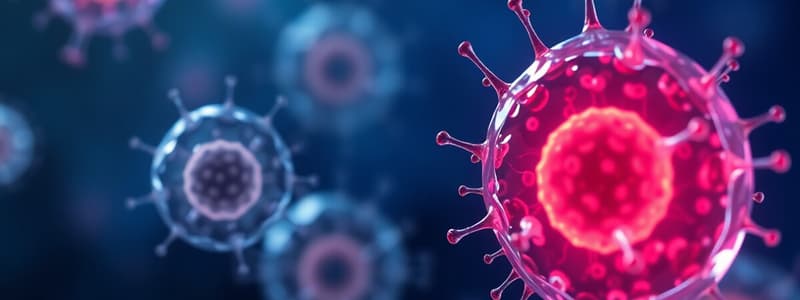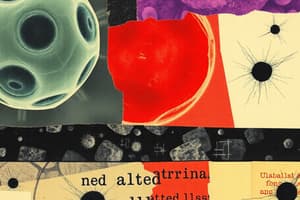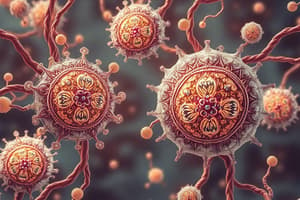Podcast
Questions and Answers
Which of the following best describes stem cells?
Which of the following best describes stem cells?
- Specialized cells that cannot divide
- Cells that only exist in embryos
- Undifferentiated cells capable of self-renewal and differentiation (correct)
- Cells that have no defined function
Apoptosis is a form of programmed cell death that occurs when a cell is damaged.
Apoptosis is a form of programmed cell death that occurs when a cell is damaged.
True (A)
What is meant by 'cell lineage'?
What is meant by 'cell lineage'?
The developmental history of a cell from its birth until its final differentiation into a specialized cell type.
Which type of stem cells have the highest potential for differentiation?
Which type of stem cells have the highest potential for differentiation?
The process of a cell dividing into two identical cells is known as __________ cell division.
The process of a cell dividing into two identical cells is known as __________ cell division.
Fetal stem cells are less powerful than adult stem cells.
Fetal stem cells are less powerful than adult stem cells.
Which of the following cell types is NOT a category of stem cells?
Which of the following cell types is NOT a category of stem cells?
What stage do human embryos reach where each cell can form every tissue?
What stage do human embryos reach where each cell can form every tissue?
Match the terms to their correct definitions:
Match the terms to their correct definitions:
Embryonic stem cells are derived from the __________ of an early-stage embryo.
Embryonic stem cells are derived from the __________ of an early-stage embryo.
Multipotent stem cells can differentiate into any cell type in the body.
Multipotent stem cells can differentiate into any cell type in the body.
Match the following types of stem cells with their characteristics:
Match the following types of stem cells with their characteristics:
What is a key characteristic of iPS cells?
What is a key characteristic of iPS cells?
What term describes stem cells that can give rise to all embryonic tissues but not extraembryonic tissues?
What term describes stem cells that can give rise to all embryonic tissues but not extraembryonic tissues?
Adult stem cells can be grown indefinitely in culture.
Adult stem cells can be grown indefinitely in culture.
Which transcription factors are crucial for maintaining the pluripotency of embryonic stem cells?
Which transcription factors are crucial for maintaining the pluripotency of embryonic stem cells?
What is the primary characteristic of multipotent cells?
What is the primary characteristic of multipotent cells?
Intestinal stem cells proliferate and generate all types of epithelial cells within the intestine.
Intestinal stem cells proliferate and generate all types of epithelial cells within the intestine.
Where are stem cells located in the intestinal epithelium?
Where are stem cells located in the intestinal epithelium?
Hematopoietic stem cells replenish all necessary _____ cells.
Hematopoietic stem cells replenish all necessary _____ cells.
Match the following terms with their descriptions:
Match the following terms with their descriptions:
What significantly controls the proliferation and differentiation of stem cells in niches?
What significantly controls the proliferation and differentiation of stem cells in niches?
Intestinal epithelial cells are only regenerated when damaged.
Intestinal epithelial cells are only regenerated when damaged.
What is the turnover rate of intestinal epithelium cells in humans?
What is the turnover rate of intestinal epithelium cells in humans?
What is the primary role of enterocytes when the Notch signal is present?
What is the primary role of enterocytes when the Notch signal is present?
Paneth cells are produced every 3-6 weeks from Lgr5+ cells.
Paneth cells are produced every 3-6 weeks from Lgr5+ cells.
What distinguishes tuft cells from other intestinal cells?
What distinguishes tuft cells from other intestinal cells?
The main function of goblet cells is to secrete ________.
The main function of goblet cells is to secrete ________.
Which factor is NOT involved in deriving induced pluripotent stem (iPS) cells?
Which factor is NOT involved in deriving induced pluripotent stem (iPS) cells?
Match the following cell types with their functions:
Match the following cell types with their functions:
What type of cell division do many yeasts and fungi undergo?
What type of cell division do many yeasts and fungi undergo?
Telocytes are the primary source of growth factors necessary for stem cell self-renewal.
Telocytes are the primary source of growth factors necessary for stem cell self-renewal.
What is a requirement for asymmetric cell division to occur?
What is a requirement for asymmetric cell division to occur?
All daughter cells produced by asymmetric cell division are identical in size and shape.
All daughter cells produced by asymmetric cell division are identical in size and shape.
What are the three components of the conserved apoptotic pathways in vertebrate cells?
What are the three components of the conserved apoptotic pathways in vertebrate cells?
Without trophic factors, vertebrate cells undergo __________.
Without trophic factors, vertebrate cells undergo __________.
Match the following terms with their descriptions:
Match the following terms with their descriptions:
What is the first step in generating polarized cells?
What is the first step in generating polarized cells?
The mitotic spindle's position can affect the fate of the daughter cells.
The mitotic spindle's position can affect the fate of the daughter cells.
Asymmetric cell division involves the unequal distribution of cell contents, such as __________ and proteins.
Asymmetric cell division involves the unequal distribution of cell contents, such as __________ and proteins.
What is the primary function of caspases once activated?
What is the primary function of caspases once activated?
Caspase activation can occur without the binding of CED-4 and Apaf-1.
Caspase activation can occur without the binding of CED-4 and Apaf-1.
What happens to apoptotic cells during the process of apoptosis?
What happens to apoptotic cells during the process of apoptosis?
Bcl-2 family proteins include both pro- and anti-______ proteins.
Bcl-2 family proteins include both pro- and anti-______ proteins.
Which proteins promote caspase activation and cell death by escaping into the cytosol?
Which proteins promote caspase activation and cell death by escaping into the cytosol?
The Bcl-2 protein facilitates apoptosis by preventing the oligomerization of Bax and Bak.
The Bcl-2 protein facilitates apoptosis by preventing the oligomerization of Bax and Bak.
What triggers the oligomerization of Bax and Bak proteins?
What triggers the oligomerization of Bax and Bak proteins?
Match each protein to its role in apoptosis:
Match each protein to its role in apoptosis:
Flashcards
Stem Cell
Stem Cell
An unspecialized cell capable of self-renewal and producing specialized cells.
Cell Lineage
Cell Lineage
The developmental history of a cell, from birth to differentiation into a specialized cell type.
Cell Fate
Cell Fate
The ultimate cell type a specific cell will develop into.
Apoptosis
Apoptosis
Signup and view all the flashcards
Embryonic Stem Cells
Embryonic Stem Cells
Signup and view all the flashcards
iPS Cells
iPS Cells
Signup and view all the flashcards
Pluripotent
Pluripotent
Signup and view all the flashcards
Multipotent
Multipotent
Signup and view all the flashcards
Totipotent
Totipotent
Signup and view all the flashcards
Progenitor Cells
Progenitor Cells
Signup and view all the flashcards
Fetal stem cells
Fetal stem cells
Signup and view all the flashcards
Embryonic stem cells
Embryonic stem cells
Signup and view all the flashcards
Induced pluripotent stem cells (iPS)
Induced pluripotent stem cells (iPS)
Signup and view all the flashcards
Totipotent cells
Totipotent cells
Signup and view all the flashcards
Pluripotent cells
Pluripotent cells
Signup and view all the flashcards
Multipotent cells
Multipotent cells
Signup and view all the flashcards
Unipotent cells
Unipotent cells
Signup and view all the flashcards
Inner Cell Mass
Inner Cell Mass
Signup and view all the flashcards
Adult stem cells
Adult stem cells
Signup and view all the flashcards
Blastocyst
Blastocyst
Signup and view all the flashcards
Multipotent stem cells
Multipotent stem cells
Signup and view all the flashcards
Stem cell population constancy
Stem cell population constancy
Signup and view all the flashcards
Transiently amplifying cells
Transiently amplifying cells
Signup and view all the flashcards
Hematopoietic stem cells
Hematopoietic stem cells
Signup and view all the flashcards
Progenitor cells and precursors
Progenitor cells and precursors
Signup and view all the flashcards
Intestinal stem cells
Intestinal stem cells
Signup and view all the flashcards
Intestinal epithelium
Intestinal epithelium
Signup and view all the flashcards
Intestinal stem cell niche
Intestinal stem cell niche
Signup and view all the flashcards
Lgr5 receptor
Lgr5 receptor
Signup and view all the flashcards
Wnt pathway
Wnt pathway
Signup and view all the flashcards
Crypts
Crypts
Signup and view all the flashcards
Absorptive enterocytes
Absorptive enterocytes
Signup and view all the flashcards
Asymmetric Cell Division
Asymmetric Cell Division
Signup and view all the flashcards
Caspase activation
Caspase activation
Signup and view all the flashcards
Cell Polarity
Cell Polarity
Signup and view all the flashcards
Apoptotic bodies
Apoptotic bodies
Signup and view all the flashcards
Necrosis vs. Apoptosis
Necrosis vs. Apoptosis
Signup and view all the flashcards
Cell Polarity Determinants
Cell Polarity Determinants
Signup and view all the flashcards
Mitotic Spindle Orientation
Mitotic Spindle Orientation
Signup and view all the flashcards
Bcl-2 family
Bcl-2 family
Signup and view all the flashcards
Trophic Factors
Trophic Factors
Signup and view all the flashcards
Bax/Bak oligomerization
Bax/Bak oligomerization
Signup and view all the flashcards
Apoptosis (Programmed Cell Death)
Apoptosis (Programmed Cell Death)
Signup and view all the flashcards
Cytochrome c release
Cytochrome c release
Signup and view all the flashcards
Pro-apoptotic BH3-only proteins
Pro-apoptotic BH3-only proteins
Signup and view all the flashcards
Caspases
Caspases
Signup and view all the flashcards
Symmetric Cell Division
Symmetric Cell Division
Signup and view all the flashcards
Trophic factors
Trophic factors
Signup and view all the flashcards
Spatial Clue
Spatial Clue
Signup and view all the flashcards
DNA damage
DNA damage
Signup and view all the flashcards
Notch signaling pathway
Notch signaling pathway
Signup and view all the flashcards
Lgr5+ cells
Lgr5+ cells
Signup and view all the flashcards
Paneth cells
Paneth cells
Signup and view all the flashcards
Transit amplifying cells
Transit amplifying cells
Signup and view all the flashcards
Reserve stem cells (+4)
Reserve stem cells (+4)
Signup and view all the flashcards
Telocytes
Telocytes
Signup and view all the flashcards
Enteroendocrine cells
Enteroendocrine cells
Signup and view all the flashcards
Tuft cells
Tuft cells
Signup and view all the flashcards
Goblet cells
Goblet cells
Signup and view all the flashcards
M cells
M cells
Signup and view all the flashcards
iPS cells
iPS cells
Signup and view all the flashcards
Symmetric cell division
Symmetric cell division
Signup and view all the flashcards
Study Notes
Stem Cells, Cell Asymmetry, and Cell Death
-
Learning Objectives: Define apoptosis, apoptosome, asymmetric/symmetric cell division, Bcl-2 family, caspases, cell fate, cell lineage, embryonic stem cells, iPS cells, multipotent, pluripotent, progenitor cells, stem cell, stem-cell niche survival signals, and totipotent. Differentiate stem cell categories. Discuss key stem cells in the intestinal stem cell niche. Compare apoptosis and necrosis.
-
Cell Lineage: Developmental history of a cell from birth to final division and differentiation is its cell fate. Cell lineage traces the birth order of cells as they progressively become more specific in development. Examples include the nematode worm C. elegans.
-
Stem Cells: Unspecialized cells capable of self-renewal and generating specialized cells. Four main types: adult stem cells (derived from adult tissues), fetal stem cells (from fetuses), embryonic stem cells (from blastocysts), and induced pluripotent stem cells (iPS) (adult cells reprogrammed).
-
Totipotent Cells: Human embryos at the 8-cell stage, each still capable of forming all embryonic and extraembryonic tissues (e.g., placental).
-
ES Cells: At the blastocyst stage, a distinctive inner cell mass can form embryonic stem cells (ES cells) that have the potential to generate all embryonic tissues, but not extraembryonic tissues. ES cells are pluripotent.
-
Pluripotency of ES Cells: Controlled by factors like DNA methylation, chromatin regulators, microRNAs, and transcription factors (Oct4, Sox2, Nanog).
-
Adult Stem Cells: Multipotent, capable of differentiating into various cell types within a specific tissue, but less versatile than ES cells. Important for tissue maintenance and repair.
-
Polarized Cells: Cells that develop a distinct orientation. Cells use receptors to sense cues, initiate signal transduction pathways, and reorganize their cytoskeleton.
-
Cell Polarity Determinants: MRNAs, proteins, and lipids organized in a non-uniform, localized way within the cell. This organization leads to different fate determinants in daughter cells during the cell division.
-
Cell Death (Apoptosis): Programmed cell death in vertebrates, with three components: membrane-bound regulatory proteins, cytosolic regulatory proteins, and apoptotic proteases (caspases).
-
Apoptotic Pathways: Activated caspases cleave specific intracellular substrates leading to cell demise. Other proteins (CED-4 and Apaf-1) are essential for caspase activation. Apoptotic cells shrink, condense, and fragment. They are engulfed, versus necrotic cells.
-
Bcl-2 Family Proteins: Transmembrane proteins containing pro- and anti-apoptotic members. Pro-apoptotic Bcl-2 family members (Bax and Bak) form channels in the mitochondrial membrane leading to cell death, while anti-apoptotic members (Bcl-2, Bcl-XL) prevent oligomerization of Bax/Bak and cell death.
-
Fas-mediated Apoptosis: Binding of extracellular death signals (e.g., TNFα and Fas Ligand) to their respective receptors triggers the caspase cascade.
Studying That Suits You
Use AI to generate personalized quizzes and flashcards to suit your learning preferences.



